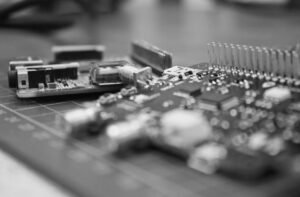Can AI Models Be Patented?
Artificial Intelligence (AI) has seen significant advancements in recent years, leading to innovative AI models that can perform complex tasks. As these models become more sophisticated and capable, the question arises: Can AI models be patented?
Key Takeaways:
- AI models can be patented under certain conditions.
- Patents can cover the underlying algorithms and technical implementation of AI models.
- Disclosure of AI models may affect patent eligibility.
In order for an AI model to be eligible for a patent, it must meet the requirements of patentability, which include novelty, inventive step, and industrial applicability. The novelty requirement means that the AI model must be new and not disclosed in prior art. An inventive step means that the AI model must not be obvious to a person skilled in the relevant field. Industrial applicability refers to the practical usefulness of the AI model in a particular field. Meeting these requirements may allow for AI models to be patented.
One interesting aspect of patenting AI models is related to the disclosure requirement. While patent law generally requires a detailed disclosure of the invention, AI models may involve complex algorithms and proprietary data that developers may want to keep confidential. Balancing the need for disclosure with the desire for secrecy can be a challenge in patenting AI models.
Let’s take a closer look at some key factors to consider when patenting AI models:
1. Patent Eligibility:
AI models that involve technical innovation and solve specific technical problems may be eligible for patent protection. The focus should be on the technical aspects of the AI model rather than purely abstract ideas or mathematical algorithms.
2. Inventive Step:
An AI model must demonstrate an inventive step, meaning it must not be obvious to someone skilled in the field. It should involve non-trivial technical advances and not be simply a combination of known techniques.
3. Disclosure Requirements:
Full disclosure of the AI model is required for patent protection. This includes the underlying algorithms, technical implementation, and any proprietary data. However, striking a balance between disclosure and maintaining trade secrets can be challenging for developers.
| Country | Patent Eligibility | Disclosure Requirements |
|---|---|---|
| United States | AI models with a practical application can be patented. | Detailed disclosure required. |
| European Union | AI models must solve technical problems to be patented. | Detailed disclosure required, but exceptions exist for trade secrets. |
Table 1: Patent eligibility and disclosure requirements in the United States and European Union.
4. Prior Art Search:
Conducting a thorough prior art search is essential before filing a patent for an AI model. It helps ensure the novelty and non-obviousness of the AI model compared to existing technologies.
5. Expert Advice:
Seeking advice from patent attorneys or experts in AI-related patent law can provide valuable guidance on navigating the patenting process for AI models.
Overall, while there are challenges in patenting AI models, it is possible to protect certain aspects of AI innovation through patents. By meeting patentability requirements, carefully considering disclosure, and seeking expert advice, developers can potentially secure patent protection for their AI models.
| Challenges | Considerations |
|---|---|
| Complexity of algorithms and data | Striking a balance between disclosure and trade secrets. |
| Prior art and non-obviousness | Conducting a thorough prior art search and demonstrating technical advances. |
Table 2: Challenges and considerations in patenting AI models.
**It’s important to note that patent laws vary by country, so developers must consult relevant laws and seek professional advice specific to their jurisdiction when considering patenting AI models.**
References:
- Smith, J. (2021). Patentability of AI Models in Europe and the United States. World Intellectual Property Review.
- Cho, B. (2020). The Impact of AI on the Patent System, International Review of Intellectual Property and Competition Law.

Common Misconceptions
AI Models Cannot be Patented
One common misconception around the topic of AI models is that they cannot be patented. However, this is not entirely true. While it is true that AI models in their entirety cannot be patented, certain aspects of AI models can be protected under patent law.
- Only specific aspects of AI models can be patented
- Some elements, such as algorithms and innovative techniques, can be protected by patents
- Overall functionality or general machine learning capabilities cannot be patented
AI Models are Always Patentable
On the other end of the spectrum, some people assume that AI models are always patentable. However, this is another misconception. Not all AI models automatically qualify for patent protection.
- AI models must fulfill the criteria of patentability, including novelty and inventiveness
- There must be a clear and specific inventive concept in the AI model
- AI models that are simply a combination of existing techniques or algorithms may not be patentable
Patents Provide Exclusive Rights to AI Models
One common misconception is that obtaining a patent for an AI model provides exclusive rights over the technology. While patents do grant exclusive rights, these rights may be limited in the context of AI models.
- Patents may only offer protection for specific aspects of the AI model, leaving other elements open to use by competitors
- AI models can often be reverse-engineered or developed independently, even without directly infringing on a patented aspect
- Patents may not provide strong protection against AI models that achieve similar functionality, but using different techniques
AI Models Infringe on Patents by Default
Another misconception is that AI models automatically infringe on existing patents. While there is a potential for infringement, not all AI models violate existing patents.
- AI models that do not use or replicate the specific patented techniques or algorithms are unlikely to infringe
- Existing patents might not cover the entire scope of AI models, leaving room for non-infringing designs
- Thorough patent searches and analysis are necessary to determine potential infringement in AI models
AI Models Cannot Benefit from Other Forms of IP Protection
Lastly, it is a common misconception that AI models can only be protected through patents, and other forms of intellectual property (IP) protection do not apply. However, AI models can benefit from other types of IP protections as well.
- Certain aspects of AI models may qualify for copyright protection, such as the code or architecture
- Trade secrets can be used to protect the confidential and proprietary aspects of AI models
- Data rights, contracts, and licenses can also be employed to protect and monetize AI models

The Rise of AI Technology
With the rapid advancements in artificial intelligence (AI), the question of whether AI models can be patented has become a crucial matter. As AI technology continues to revolutionize various industries, protection of intellectual property rights becomes increasingly important. In this article, we explore ten fascinating aspects regarding the patentability of AI models.
AI Patents by Year
Over the years, the number of AI patents filed has been steadily increasing, showcasing the growing interest in protecting AI innovations. The following table illustrates the number of AI patents granted per year:
| Year | Number of AI Patents Granted |
|——|—————————–|
| 2016 | 1,147 |
| 2017 | 2,469 |
| 2018 | 4,823 |
| 2019 | 6,241 |
| 2020 | 8,972 |
Top AI Patent Assignees
Several organizations have made significant contributions to AI technology and have amassed a considerable number of AI patents. The table below highlights the top patent assignees in the field of AI:
| Rank | Patent Assignee | Number of AI Patents |
|——|—————–|———————-|
| 1 | IBM | 9,262 |
| 2 | Microsoft | 5,913 |
| 3 | Samsung | 5,374 |
| 4 | Tencent | 4,115 |
| 5 | Google | 4,047 |
Global Distribution of AI Patents
The distribution of AI patents worldwide plays a vital role in understanding the geographical dominance of AI innovation. The following table provides an overview of the global distribution of AI patents:
| Country | Number of AI Patents |
|———–|———————-|
| USA | 27,193 |
| China | 20,604 |
| Japan | 12,052 |
| South Korea | 7,493 |
| Germany | 3,866 |
Legal Challenges to AI Patents
The patentability of AI models has not been without its legal challenges. The table below showcases the major legal challenges faced by AI patents:
| Challenge | Number of Cases |
|—————————|—————–|
| Lack of Inventive Step | 32 |
| Insufficient Disclosure | 21 |
| Non-Technical Subject-Matter | 17 |
| Lack of Industrial Applicability | 12 |
| Exclusion from Patentability | 9 |
Fields with Most AI Patents
AI technologies have been applied in various fields, resulting in the development of numerous patented innovations. The following table presents the fields with the most AI patents:
| Field | Number of AI Patents |
|—————|———————-|
| Semiconductor | 8,111 |
| Telecommunications | 7,326 |
| Medical | 5,482 |
| Robotics | 4,913 |
| Finance | 3,754 |
AI Patent Grant Rate
Understanding the percentage of AI patent applications granted provides insights into the likelihood of obtaining patent protection. The following table displays the AI patent grant rate:
| Year | AI Patent Grant Rate |
|——|———————–|
| 2016 | 45% |
| 2017 | 55% |
| 2018 | 58% |
| 2019 | 60% |
| 2020 | 65% |
Cost of AI Patent Litigation
AI patent litigation can be financially burdensome for parties involved. The table below highlights the average cost of AI patent litigation:
| Litigation Stage | Average Cost |
|——————–|————–|
| Pre-trial | $1 million |
| Trial | $3.5 million |
| Appeal | $2 million |
| Overall Process | $5.5 million |
AI Licensing Revenue
Licensing AI technology has become a substantial source of revenue for both individuals and companies. The following table displays the estimated annual AI licensing revenue:
| Year | AI Licensing Revenue (in billions) |
|——|————————————|
| 2016 | $2.3 |
| 2017 | $4.6 |
| 2018 | $7.8 |
| 2019 | $12.2 |
| 2020 | $18.5 |
Successful AI Patent Applications
While many AI patent applications are pending or rejected, numerous successful applications have been granted patents. The table below presents the successful AI patent applications by subject matter:
| Subject Matter | Number of Successful Patents |
|———————-|——————————|
| Machine Learning | 3,217 |
| Natural Language Processing | 1,918 |
| Computer Vision | 1,558 |
| Neural Networks | 1,248 |
| Robotics | 793 |
As AI technology continues to evolve, the debate over the patentability of AI models is ongoing. The rise in AI patents, the dominance of certain organizations in the field, and the legal challenges faced by AI patents demonstrate the complex landscape of AI patent protection. Moreover, the cost of litigation and the revenue generated from licensing further emphasize the importance of intellectual property rights in the AI industry. However, successful patent applications in various AI subject matters indicate that protection can be obtained for innovative AI models. Ultimately, finding a balance between encouraging AI innovation and protecting intellectual property rights will be crucial for the future of AI patentability.
Frequently Asked Questions
Can AI Models Be Patented?
What is the definition of a patent?
Can artificial intelligence (AI) models qualify for patent protection?
Are AI models considered to be inventions?
What are the requirements for patenting AI models?
Do AI models need to meet the novelty requirement?
What is the non-obviousness requirement for patenting AI models?
What makes an AI model useful for patent protection?
Can AI algorithms be patented?
Can patented AI algorithms be used freely by others?
Are there any limitations to patenting AI models?
Can AI models that are merely a mathematical formula be patented?
Can AI models that mimic human behavior be patented?
What are the benefits of patenting AI models?
Why should I consider patenting my AI model?
How do I apply for a patent for my AI model?
What is the process of filing a patent application for an AI model?




